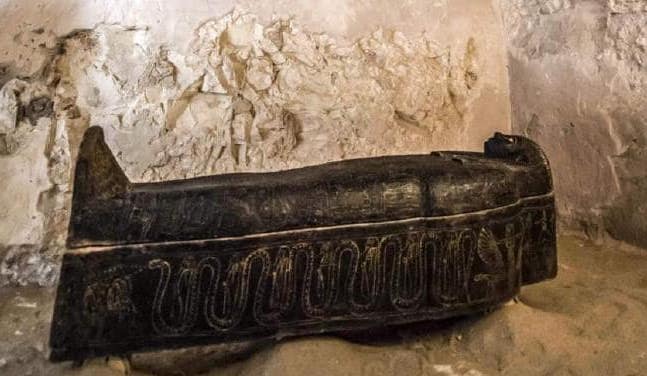News sources are reporting that an ancient Egyptian sarcophagus was opened live on TV on the dates of April 7-8, 2019, with a two-hour Discovery Channel show hosted by Chris Jacobs and explorer Josh Gates. An excavation team negotiated an underground network of chambers and tunnels. It is thought 40 mummies, once part of the elite nobility, are entombed there. Jacobs and Gates were accompanied by the world renowned Egyptologist Dr. Zahi Hawass along with secretary-general of the Supreme Council of Antiquities of Egypt, Mostafa Waziri.
The live broadcast was filmed in the inner chambers of an excavation, the exact site of which has not been disclosed. Archaeologists recently found a network of vertical shafts that lead to tunnels and tombs that remained undisturbed for thousands of years. A “mysterious limestone sarcophagus was found buried deep within the complex,” Discovery said in a statement. “The identity of the mummy inside has been a mystery for 3,000 years. Possibly until now,” it added.
The first Great Ancient Egyptian dynasty began around 3,100 B.C. Earlier societies existed in the same region thousands of years before this, but the “age of the pyramids” gave rise to some of the most iconic buildings of all human history, such as the Great Pyramid of Giza, built during the Old Kingdom period, between 2686 and 2181 B.C. These civilisations went into major decline around the 1200s B.C. mainly due to a series of wars and invasions, until, by 30 B.C., it had largely fallen under the power of the Roman Empire following the deaths of Marc Anthony and Cleopatra.
There are still many mysteries surrounding Ancient Egypt, especially concerning how the civilisation managed to built their pyramids. It was only two years ago that archaeologists found a huge, secret chamber within the Great Pyramid of Giza.
Last month, Egypt’s Ministry of Antiquities announced the discovery of a hidden palace in the ancient city of Abydos at the site of a royal temple of Ramesses II. The find, experts say, shows Ramesses II believed Abydos to be a royal power. “The fact Rameses II required a palace at Abydos also reveals that he didn’t just order a new temple at the site but was spending enough time there to warrant such accommodation,” according to Joann Fletcher, a visiting professor in archaeology at the University of York, in the U.K., recently.
“This has been such an amazing experience,” said Gates, following the live global broadcast. “There aren’t many people who can say they’ve gone down into unexplored ancient tombs, especially with a living legend like Dr. Hawass. We were able to document spectacular artefacts and mummies and bring viewers along in real time. It was the thrill of a lifetime.”
“Never in my 50 years in archaeology have I experienced something on such a grand scale as this,” Dr. Hawass said. “The findings here are completely special and totally unique. This is what keeps me going. It is what keeps me feeling young and alive!”
This ancient Egyptian necropolis has long remained a mystery until now. In 1927, an antiquities inspector first discovered the sarcophagus of a high priest in this area. However, the sarcophagus was robbed and the mummy was missing. In this historic moment, Discovery cameras were rolling live at the dig site as the mummy of a powerful high priest was revealed.
During the live broadcast, viewers also had the thrill of coming face to face with two other mummies that appear to be directly connected, the first of which was a female mummy based on the artifacts discovered in a cut above ground.










